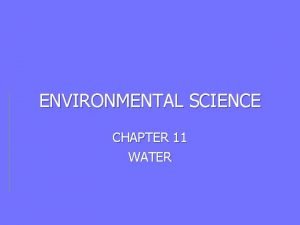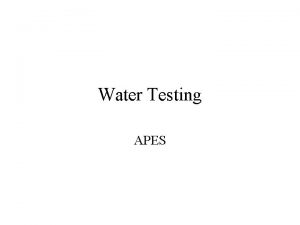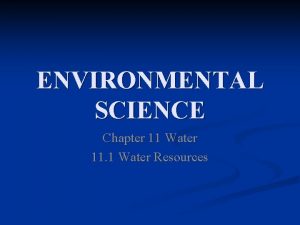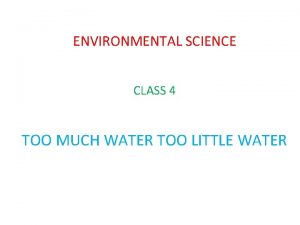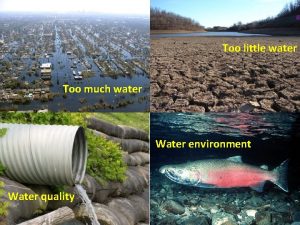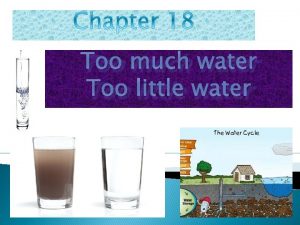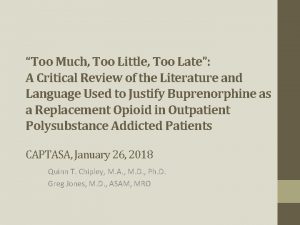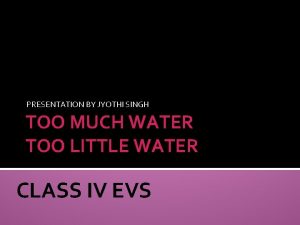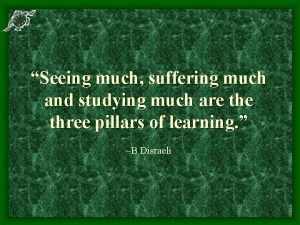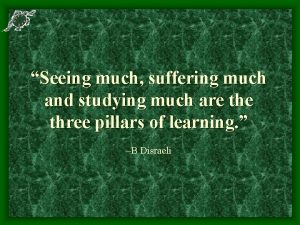ENVIRONMENTAL SCIENCE CLASS 4 TOO MUCH WATER TOO













- Slides: 13

ENVIRONMENTAL SCIENCE CLASS 4 TOO MUCH WATER TOO LITTLE WATER

WATER IS THE MOST PRECIOUS THING IN THE WORLD. GLOBAL WATER CRISIS Today 1 billion people live without clean drinking water. Water effects everything, education, health and poverty. Many people have to walk for hours just to collect enough water for the day. Often, the water that they collect is contaminated with germs that can cause very serious illnesses or even death.

REASONS FOR WATER SCARCITY. Water scarcity is caused by poor management of available water resources and the depletion of fresh water resources due to various reasons such as: Population growth and Food production Increasing construction/ infrastructure development activities Massive urbanization and industrialization throughout the country. Climatic change and variability- Depleting of natural resources due to changing climate conditions (Deforestation etc. ) Lack of implementation of effective water management systems.

What are the effects of water shortage? The effects of water scarcity can be grouped into these 4 broad areas— Health, Hunger, Education and Poverty. Health In many developing countries, people are forced to drink low quality water from flowing streams, many of which are contaminated. There are many water-borne disease that people die of. Less water also means sewage does not flow, and mosquitoes are other insects breed on still (stagnant) dirty water. The result is the deadly malaria and other infections. Lack of water or quality water causes huge sanitation issues. Clinics, local restaurants, public places of convenience and many other places are forced to use very little water for cleaning. This compromises the health of the staff and people who use the facilities.

Hunger It takes a lot of water to grow food and care for animals. Experts say that globally we use 70% of our water sources for agriculture and irrigation, and only 10% on domestic uses. Less water means farming and other crops that need water to grow have lower yield. It means farm animals will die and others will not do well without water. The result is constant hunger and thirst and low quality of life.

Education It is a bit hard to see how water and education is related. For many people in other parts of the world children (and teen girls) have to be up at dawn to collect water for the family. They have to walk for several miles to get water. The children get tired and some have to miss school as a result. Doing this for many years take away school times and the cycle continues. In other places girls and women are not allowed to go to school at all, so that they can serve the family by getting water and taking care of other family needs.

Poverty Access to quality water is key to economic prosperity and better living standards. Businesses and schools thrive when people come to work on time and not have to spend all morning looking for water. Restaurants, hotels and shopping places need to keep clean to attract tourists and foreign investments. Manufacturing activities, commercial farms, and mining processes all need a lot of water to thrive. Lack of water means no economic activities will happen and the people will be in constant poverty.

Water Borne Diseases Water borne diseases are cause for the deaths of millions of people every year. Consuming water that contains pathogenic microorganisms causes water borne diseases. In most developing countries, water borne diseases are the main cause of childhood death, especially with diarrhea. Water borne diseases are contagious and prevention of waterborne diseases requires high standards of hygiene and sanitation. In order to be acquainted with the ways to avoid water borne diseases, it is essential to first know how infection takes place.

Water borne diseases are extremely harmful and lead to severe illness and may even be fatal. They lower the body’s resistance and intake of nourishment, resulting in further infections and diseases. Therefore, prevention of waterborne diseases is vital. How Water Borne Disease Transmitted? Most of the people get infected when the contaminated material enters their mouth. Other possible modes of transmission include: Dirty contaminated hands, clothes, cooking vessels, mugs, etc. Uncovered food and drinking water Contaminated water The practice of defecating in the open Via flies

Ways to Avoid These Diseases In order to prevent infectious water borne diseases, it is important to take necessary precautions. The quality of water should be improved at the source itself. In certain areas, the quality of water supply might be of question. In such cases, it is necessary to disinfect the water before use. Water that is used for all purposes like drinking, cooking, and brushing of teeth should be disinfected properly.

RAIN WATER HARVESTING. If we were to collect all the water which rains on our terrace, roads and pavements instead of letting it run into the ditches, we could actually have vast reserves of water. All we need to do this is create rain water tanks to store water. If water tanks and reserves are expensive and difficult to maintain, we could even dig huge pits and make open reservoirs. These reservoirs would not only collect the rain water but also allow it to seep into the ground and raise the ground water level. This type of water management and storage of rain water is called water harvesting.

It is actually a very old technique that has been used by a lot of traditional societies for generations. Water tanks, check dams, storage wells and reservoirs are dotted all over rural India and have seen villagers through several summers. In Kishori village of Alwar district in Rajasthan, farmers have made Johads or check dams to trap rain water and store them in huge reservoirs. As water scarcity increases, we will also have to look towards such traditional but revolutionary water management methods.

Methods of RAIN WATER HARVESTING
 Too much too many and enough
Too much too many and enough How much caffeine in a snickers bar
How much caffeine in a snickers bar How much is too much plagiarism
How much is too much plagiarism Too much money is chasing too few goods
Too much money is chasing too few goods Water and water and water water
Water and water and water water Path food takes through the digestive system
Path food takes through the digestive system Water that contains waste from homes or industry
Water that contains waste from homes or industry Bod apes
Bod apes Water table environmental science
Water table environmental science Rule of 70 population growth
Rule of 70 population growth To whom much is given much is required meaning
To whom much is given much is required meaning The world is too much with us william wordsworth analysis
The world is too much with us william wordsworth analysis Oxymoron in the world is too much with us
Oxymoron in the world is too much with us The world is too much with us images
The world is too much with us images






